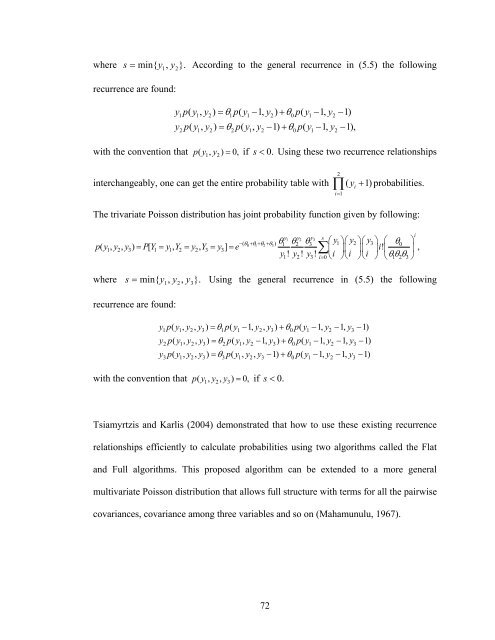multivariate poisson hidden markov models for analysis of spatial ...
multivariate poisson hidden markov models for analysis of spatial ...
multivariate poisson hidden markov models for analysis of spatial ...
You also want an ePaper? Increase the reach of your titles
YUMPU automatically turns print PDFs into web optimized ePapers that Google loves.
where s = min{ y 1,<br />
y 2}.<br />
According to the general recurrence in (5.5) the following<br />
recurrence are found:<br />
ypy ( , y) = θ py ( − 1, y) + θ py ( −1, y −1)<br />
1 1 2 1 1 2 0 1 2<br />
ypy ( , y) = θ py ( , y− 1) + θ py ( −1, y−1),<br />
2 1 2 2 1 2 0 1 2<br />
with the convention that py (<br />
1, y<br />
2) = 0, if s < 0. Using these two recurrence relationships<br />
interchangeably, one can get the entire probability table with<br />
2<br />
∏<br />
i=<br />
1<br />
( y + 1) probabilities.<br />
i<br />
The trivariate Poisson distribution has joint probability function given by following:<br />
y1 y2<br />
y3<br />
s<br />
− ( θ0+ θ1+ θ2+<br />
θ3) θ1 θ2<br />
θ3 ⎛y1⎞⎛y2⎞⎛y<br />
3 ⎞ ⎛ θ ⎞<br />
0<br />
py (<br />
1, y2, y3) = PY [<br />
1= yY<br />
1, 2<br />
= y2, Y3 = y3] = e ∑ ⎜ ⎟⎜ ⎟⎜ ⎟i! ⎜ ⎟ ,<br />
y1! y2! y3!<br />
i=<br />
0 ⎝i<br />
⎠⎝i<br />
⎠⎝i<br />
⎠ ⎝θθθ<br />
1 2 3⎠<br />
i<br />
where s = min{ y1,<br />
y2,<br />
y3}.<br />
Using the general recurrence in (5.5) the following<br />
recurrence are found:<br />
y p( y , y , y ) = θ p( y − 1, y , y ) + θ p( y −1, y −1, y −1)<br />
1 1 2 3 1 1 2 3 0 1 2 3<br />
y p( y , y , y ) = θ p( y , y − 1, y ) + θ p( y −1, y −1, y −1)<br />
2 1 2 3 2 1 2 3 0 1 2 3<br />
y p( y , y , y ) = θ p( y , y , y − 1) + θ p( y −1, y −1, y −1)<br />
3 1 2 3 3 1 2 3 0 1 2 3<br />
with the convention that py (<br />
1, y2, y<br />
3) = 0, if s < 0.<br />
Tsiamyrtzis and Karlis (2004) demonstrated that how to use these existing recurrence<br />
relationships efficiently to calculate probabilities using two algorithms called the Flat<br />
and Full algorithms. This proposed algorithm can be extended to a more general<br />
<strong>multivariate</strong> Poisson distribution that allows full structure with terms <strong>for</strong> all the pairwise<br />
covariances, covariance among three variables and so on (Mahamunulu, 1967).<br />
72















